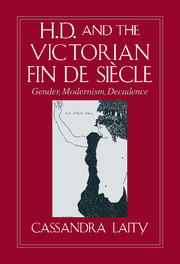Book contents
- Frontmatter
- Contents
- Acknowledgments
- Introduction: Dramatis Personae: The Aesthete Androgyne and the Femme Fatale
- 1 The Rhetoric of Anti-Romanticism: Gendered Genealogies of Male Modernism
- 2 H.D.'s Early Decadent Masks and Images: HER; Sea Garden
- The Aesthete Androgyne
- The Femme Fatale
- Postscript
- Notes
- Index
- CAMBRIDGE STUDIES IN AMERICAN LITERATURE AND CULTURE
Introduction: Dramatis Personae: The Aesthete Androgyne and the Femme Fatale
Published online by Cambridge University Press: 06 January 2010
- Frontmatter
- Contents
- Acknowledgments
- Introduction: Dramatis Personae: The Aesthete Androgyne and the Femme Fatale
- 1 The Rhetoric of Anti-Romanticism: Gendered Genealogies of Male Modernism
- 2 H.D.'s Early Decadent Masks and Images: HER; Sea Garden
- The Aesthete Androgyne
- The Femme Fatale
- Postscript
- Notes
- Index
- CAMBRIDGE STUDIES IN AMERICAN LITERATURE AND CULTURE
Summary
This book argues foremost that H.D. eluded the male modernist flight from Romantic “effeminacy” and “personality” by embracing the very cults of personality in the British fin de siècle that her contemporaries most deplored: the cult of the demonic femme fatale and that of the Aesthete androgyne. As I hope to demonstrate, Swinburne's decadent Hermaphroditus or the crystal man of Pater's androgynous, homoerotic Aestheticism lies behind the mask of the “crystalline youth” H.D. adopted throughout the 1920s in Hippolytus Temporizes and elsewhere, while in her later work, Swinburne's and Rossetti's Pre-Raphaelite femmes fatales inform Trilogy's exploding, abject poetic of reviled Venuses – Venus herself, Lilith, Mary Magdalene, and others.
My study first became organized around the figures of the Decadent femme fatale and the male androgyne because their outlines were almost always discernible behind male modernist denouncements of Romantic personality in favor of modernist “impersonality,” and by contrast, in the active, desiring “I” of H.D.'s shifting feminine modernism. These sexually dissident masks formed a convenient nexus for the ongoing debates about sexuality and gender provoked by such historical or social phenomena as the New Woman, the sexologists' theories of female inversion, and the crisis in male sexual definition engendered by Oscar Wilde's infamous trials. Moreover, in the gendered and competing schemes of Romantic influence configured by contrasting male and female agendas for modern poetry, the fatal woman and the male Aesthete androgyne often enact the paradigmatic repulsion/attraction to the maternal feminine that literary critics are currently finding inscribed throughout corresponding strains of male and female modernisms.
- Type
- Chapter
- Information
- H. D. and the Victorian Fin de SiècleGender, Modernism, Decadence, pp. ix - xxPublisher: Cambridge University PressPrint publication year: 1996



